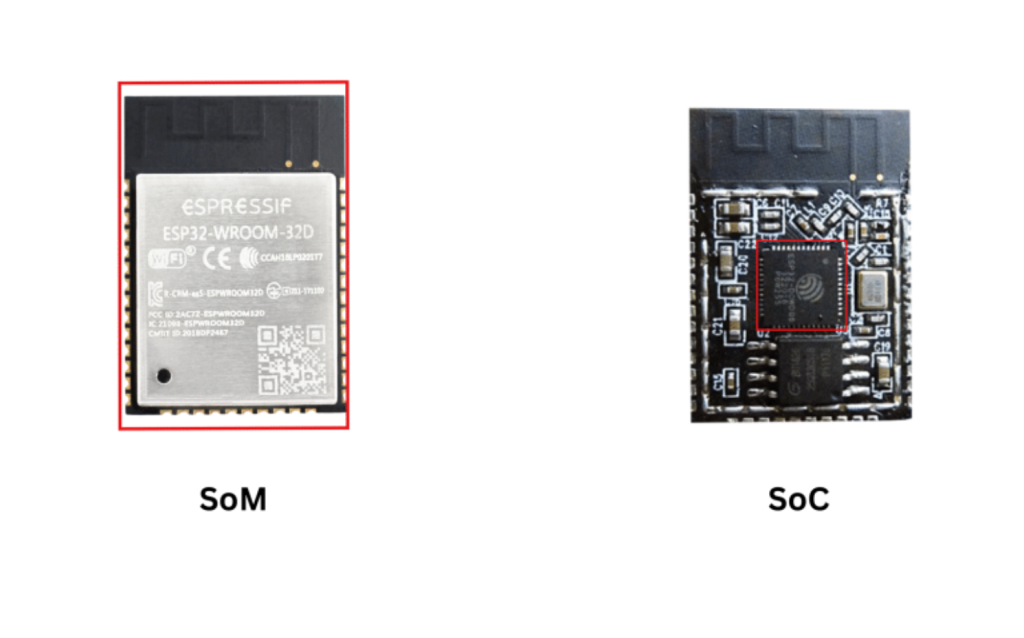A SoC is a single chip that integrates key functions but requires external components, while a SoM is a ready-to-use module that includes a SoC plus supporting circuitry like power, memory, and RF, simplifying integration.
The decision which one to use is a trade-off between full control (SoC) and faster deployment with lower RF risk (SoM).
This post outlines when each makes sense.
Table of Content
ToggleWhat is a SoC?
A System on Chip (SoC) is a highly integrated semiconductor device that combines key components such as:
- CPU
- Memory controller
- I/O peripherals (SPI, UART, ADC, etc.)
- Wireless radios (e.g., Bluetooth, Wi-Fi)

Source : ansys
These are packaged on a single chip but still require external components, including:
- Flash memory
- Power regulation
- RF passives and antenna
- Crystal oscillators
SoCs give you fine-grained control but also expose you to RF layout challenges, power integrity issues, and certification overhead. They are best suited for teams that want deep customization and are prepared to handle the resulting complexity.
What is a SoM?
A System on Module (SoM) is a pre-assembled, compact board that includes an SoC and supporting components such as:
- Flash and crystal
- Power regulation circuitry
- RF filters and matched antennas
- Wireless certifications (e.g., CE, FCC)
- Shielding for EMI/EMC compliance
- Pre-soldered interface for integration into a carrier board

Source: microchip
In short, an SoM packages the core complexity of an embedded system into a plug-and-play module, abstracting away much of the RF and power design risk.
Some popular SoMs in low-power devices include ESP32-WROOM, NXP i.MX modules, and Nordic Thingy modules, which are pre-certified and field-tested.
When to Choose a SoM
Choose a SoM if:
- Your team lacks RF or EMI layout expertise
- You want to accelerate development and reduce time-to-market
- You want to avoid the cost and effort of wireless certifications
- Your product does not require highly customized hardware
- You’re not optimizing for every cent of BOM cost
- You want to reduce integration and field risk

Use cases: early-stage startups, rapid prototyping, low-volume production, constrained teams
When to Choose a SoC
Use a SoC (instead of a SoM) if:
- You need full control over hardware design
- You’re building at high volume and must optimize unit cost
- You’re prepared for RF testing, EMI compliance
- You’re prepared for product certification
- Your team has in-house hardware and wireless design expertise
- You want to tightly integrate the SoC with your application circuit

Use cases: mature hardware teams, consumer electronics, wearables, price-sensitive products
| Feature | SoC | SoM |
| Integration Effort | High | Low |
| Time to Market | Longer | Faster |
| Design Flexibility | Maximum | Moderate |
| Wireless Certification | Required | Often pre-certified |
| Unit Cost | Lower (at scale) | Higher (but predictable) |
| Ideal For | Custom, high-volume products | Rapid dev and lower-risk rollout |
What we recommend
If your product targets low- to medium-volume markets, and time-to-market or certification complexity is a concern, a SoM-based design gives you speed, simplicity, and reliability.
If you’re building cost-sensitive consumer products and can afford upfront engineering effort, then a SoC-based design can reduce your BOM and offer tighter hardware optimization.
Need help choosing or building?
At Oxeltech, we design both SoC- and SoM-based solutions for wearables, IoT, and ultra-low-power devices. Whether you’re just getting started or scaling up a validated prototype, we can help you:
- Evaluate tradeoffs for cost, power, and scalability
- Design robust PCBs for RF-sensitive systems
- Navigate certification paths for CE, FCC, and more
- Accelerate your go-to-market with the right platform choices
Reach out https://oxeltech.de/contact-us/ if you’re planning your next embedded/electronic product.


